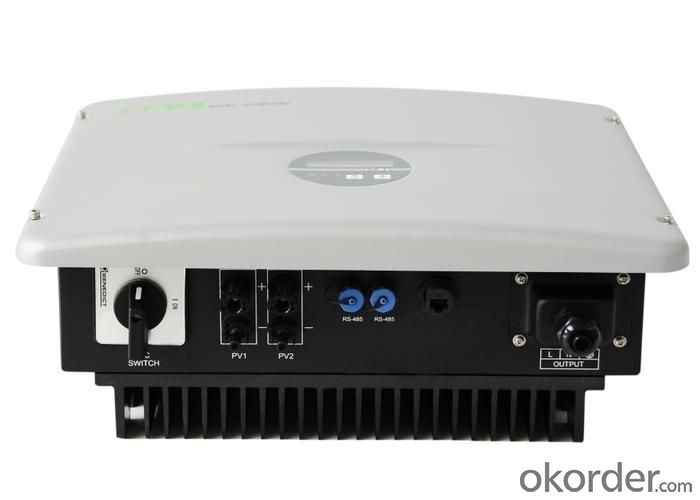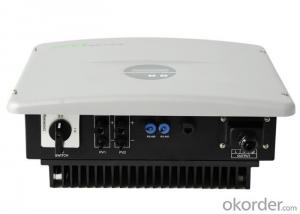Ongrid solar inverter Sununo-TL1.5K,1 MPPT
- Loading Port:
- Guangzhou
- Payment Terms:
- TT OR LC
- Min Order Qty:
- 1 pc
- Supply Capability:
- 3000 pc/month
OKorder Service Pledge
OKorder Financial Service
You Might Also Like
The Sununo-TL1K/1.5K/2K solar inverter offers a range of benefits, including maximum energy harvesting,
through both its highspeed Maximum Power Point Tracker (MPPT) and transformerless technology.Combing the wide input voltage range makes the inverter suitable to low power installations with reduced string size.
The LCD display is to check real-time performance through its integrated data logger and more communication interfaces make it convenient for remote performance monitoring. The Sununo-TL1K/1.5K/2K is an ideal inverter for smaller residential PV plants.
Futures:
■Super junction MOSFET integrated with 97.4% Max. efficiency.
■ Wide MPPT voltage range and low minimum MPPT voltage for flexible configuration.
■ Transformerless design for lower cost and compact size.
■ IP65 and fan-less for longer-term reliability.
■ Ethernet/ Wi-Fi communication interface.
■ Integrated Web Server for local and internet monitoring.
■ Support SAJ Web Portal Monitoring Solutions.
Technical data:
| Model | Sununo-TL1K | Sununo-TL1.5K | Sununo-TL2K |
| Max. DC power [W] | 1200 | 1800 | 2300 |
| Max. DC voltage [V] | 480 | 480 | 480 |
| MPPT DC voltage Range [V] | 90-425 | 100-425 | 100-425 |
| Nominal DC voltage [V] | 360 | 360 | 360 |
| start voltage [V] | 100 | 150 | 150 |
| Min.DC voltage [V] | 80 | 100 | 100 |
| Max.DC input current [A] | 10 | 11 | 12 |
| Number of MPPT | 1 | 1 | 1 |
| string per MPPT | 1 | 1 | 1 |
| DC switch | optional | optional | optional |


1. How can I get after sale service?
We have established after sale service center in Europe, North America, south East Asia, etc. you can email us or call the hot line.
2. Do you have shipping insurance for our goods?
We will buy shipping insurance according to customers’ demand.
3. Do you accept OEM or customized design?
OEM & ODM, any your customized lightings we can help you to design and put into product.
4. What if I need specific design?
Distributorship are offered for your unique design and some our current models.
- Q:Can a solar inverter be used with multiple solar arrays?
- Yes, a solar inverter can be used with multiple solar arrays. In fact, many solar power systems consist of multiple arrays connected to a single inverter. The inverter's role is to convert the DC power generated by the solar arrays into usable AC power for household or grid consumption. By connecting multiple arrays to a single inverter, it allows for greater energy production and efficiency, making it a common practice in larger solar installations.
- Q:What is the importance of insulation resistance measurement in a solar inverter?
- Insulation resistance measurement in a solar inverter is crucial as it helps ensure the safety and efficiency of the electrical system. By measuring the insulation resistance, any potential faults or deteriorations in the insulation can be detected, preventing electrical leakage or short circuits. This measurement also helps identify any insulation breakdowns that may compromise the performance and reliability of the solar inverter. Ultimately, insulation resistance measurement is essential for maintaining the integrity of the solar inverter and ensuring the safety of both the electrical system and the people using it.
- Q:What is the function of a solar inverter in a solar power system?
- The function of a solar inverter in a solar power system is to convert the direct current (DC) produced by the solar panels into alternating current (AC), which is the type of electricity used in most homes and businesses. This allows the solar energy to be utilized for powering electrical appliances, feeding excess energy back into the grid, or storing it in batteries for later use.
- Q:How does the input frequency range affect the performance of a solar inverter?
- The input frequency range directly affects the performance of a solar inverter. The inverter is designed to convert the variable direct current (DC) generated by the solar panels into stable alternating current (AC) that can be used by household appliances or fed into the grid. If the input frequency deviates from the specified range, it can lead to inefficient or unstable operation of the inverter. A wider input frequency range allows the inverter to handle fluctuations in the solar power generation, ensuring optimal performance and compatibility with different grid conditions.
- Q:Are there any safety concerns associated with solar inverters?
- Yes, there are some safety concerns associated with solar inverters. One of the primary concerns is the risk of electrical shocks or fires due to faulty installation or maintenance of the inverter. Additionally, some inverters may generate heat during operation, and if not properly ventilated, it can pose a fire hazard. It is crucial to follow proper installation guidelines, regularly maintain the inverter, and hire qualified professionals to minimize these safety risks.
- Q:What is the difference between a PV inverter and a solar inverter?
- The main component of the inverter is the three-phase bridge converter. The main purpose of the grid-connected inverter is to change the power to DC and change the AC power. The main purpose is to improve the power quality (because the wind power generation is very large
- Q:What is the role of a solar inverter in power quality management?
- The role of a solar inverter in power quality management is to convert the direct current (DC) generated by solar panels into alternating current (AC) that can be used to power electrical devices. Additionally, solar inverters play a crucial role in managing and maintaining the quality of power supplied to the grid, ensuring it meets the required voltage and frequency standards. They help in mitigating issues like voltage fluctuations, harmonics, and power factor imbalances, thereby improving the overall power quality and stability of the electrical system.
- Q:Can a solar inverter be used with solar trackers?
- Yes, a solar inverter can be used with solar trackers. Solar trackers are designed to move solar panels throughout the day to optimize their exposure to the sun. The inverter is responsible for converting the DC electricity generated by the solar panels into AC electricity that can be used to power various appliances and devices. Therefore, the inverter is an essential component in any solar power system, including those with solar trackers.
- Q:How do I choose the right solar inverter for my system?
- When choosing the right solar inverter for your system, there are a few key factors to consider. First, determine the size and capacity of your solar panels to ensure compatibility. Next, consider the type of inverter you need, whether it's a string inverter, micro inverter, or power optimizer. Additionally, assess the efficiency and reliability of the inverter, as well as its warranty and after-sales support. Finally, consider your budget and any specific features you may require, such as monitoring capabilities or grid connectivity options. It's important to research and compare different models to find the one that best fits your specific solar system needs.
- Q:Can a solar inverter be used with a wind turbine?
- Certainly! It is indeed possible to utilize a solar inverter alongside a wind turbine. Both wind turbines and solar panels generate direct current (DC) electricity, which necessitates conversion to alternating current (AC) in order to power the majority of household appliances and connect to the electrical grid. The primary function of a solar inverter is to convert DC electricity produced by solar panels into AC electricity. Interestingly, it can also perform the task of converting DC electricity generated by a wind turbine into AC electricity. However, it is worth mentioning that wind turbines typically produce higher voltage and fluctuating currents in comparison to solar panels. As a result, the inverter employed with a wind turbine may require specific design considerations to effectively manage these variations. Additionally, it is common for wind turbines to possess their own specialized inverters that are meticulously optimized to suit their unique electrical characteristics.
1. Manufacturer Overview |
|
|---|---|
| Location | |
| Year Established | |
| Annual Output Value | |
| Main Markets | |
| Company Certifications | |
2. Manufacturer Certificates |
|
|---|---|
| a) Certification Name | |
| Range | |
| Reference | |
| Validity Period | |
3. Manufacturer Capability |
|
|---|---|
| a)Trade Capacity | |
| Nearest Port | |
| Export Percentage | |
| No.of Employees in Trade Department | |
| Language Spoken: | |
| b)Factory Information | |
| Factory Size: | |
| No. of Production Lines | |
| Contract Manufacturing | |
| Product Price Range | |
Send your message to us
Ongrid solar inverter Sununo-TL1.5K,1 MPPT
- Loading Port:
- Guangzhou
- Payment Terms:
- TT OR LC
- Min Order Qty:
- 1 pc
- Supply Capability:
- 3000 pc/month
OKorder Service Pledge
OKorder Financial Service
Similar products
New products
Hot products
Hot Searches
Related keywords





























